Small Creatures other than Insects and Spiders
This page contains information about other small creatures that we found in the Brisbane area, Queensland, Australia.
When we go to the bush and look for the insects and spiders, we always find some other small creatures which are as interesting and beautiful as the insects and spiders. We recorded them in this page as well.
- Red Velvet Mite

- Order: Acari, family: Trombidiidae, body length 5mm
- This is not an insect nor a spider, this is a mite. We find this in Daisy Hill Forest under a fallen tree bark. The body size included head is 5mm, as a mite, it is very big. Like spiders they have eight legs. The body look soft and like a minute strawberry.
- Scrub Tick

- Order: Acari, body Length 5mm
- We sometimes find this Tick on our clothes after or during bush-walking (only when we walked into the bush with dense vegetations where is no obvious paths, otherwise it is quite safe for our Brisbane Bush-walking). The tick will try to climb to our neck or armpit, finds the soft skin, bite and suck our blood. Their body size could be double or triple after feeding. I had a few times bitten by them on my neck. Every time they were firmly attached to my skin and had to spend some effort to remove them. As advised by the reference books, I removed them very carefully and not to squeeze them as to avoid more of their toxin saliva enter my wound. Even so I had the small swelling on my neck and itch for two weeks.
- Lamington Plateau Cray

- Body length 140mm
- I took this picture in Lamington National Park near Natural bridge just after dark. The crayfish was wandering along the foot path in the rainforest. We nearly step on it in the dark. The crayfish was creamy blue in colour with white colour around the joints and on it head. It has a pair of well developed claws and try to attack us when I took the picture. This is a freshwater crayfish related to crabs and prawns. They belong to a group of animals called crustaceans. They are close relatives to Insects and Spiders, both have a hard skeleton on the outside.
- Snail
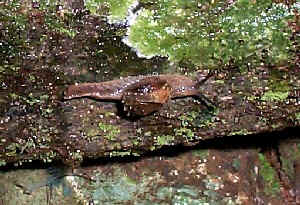
- Shell diameter 12mm
- Sedgefrog
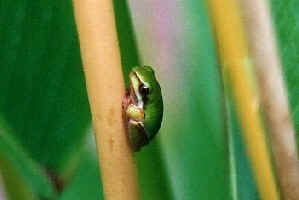
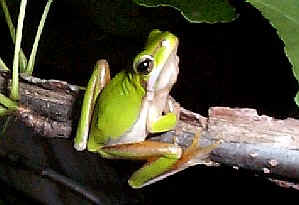
- Litoria olongburensis, body length 18-25mm
- The first time we saw this frog was in the bush near Bulimba Creek. At first I though this jumping fellow was a grasshopper, because this was so small and green in colour. Then I found out that it was a Sedgefrog. We can also find them in front of Mt Coot-tha Library, where they share the pools with the dragonflies. The frog is green on the back and green yellow on the bottom. There is a black golden line along its mouth to the eyes and to the hind legs. If not disturbed, they just sit on the stem of the plants in the pools. The second picture was taken in our backyard lately (24/04/01).
- Frog
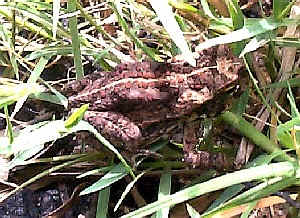
- Body length 60mm
- This picture was taken at Bulimba Creek in Wishart in late summer. The frog is dark greenish brown in colour, with reddish brown spots on the black. There is the white yellow line along the middle of its back.
- Green Treefrog
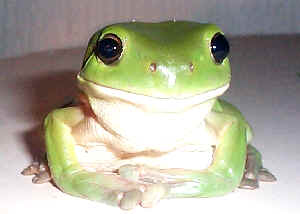
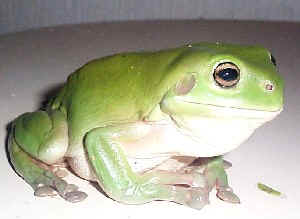
- Litoria caerulea, body length 100mm
- This Green Treefrog visited our backyard from time to time. Sometimes it sits on one of our trees, sometimes on our fence. I found it once sit on our roof. This treefrog has a funny smiling looking face. Its back is creamy green and the belly is white in colour. I found it once in a changing room near the beach when it was sitting on a chair. I through it was a plastic toy and try to pick it up. I was scared when it struggled away.
- Broad-palmed Rocketfrog
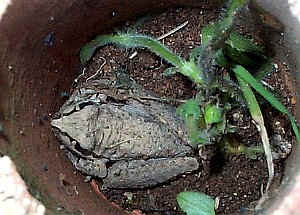
- Litoria latopalmata, body length 50mm
- We took this picture in mid-winter while the frog was in habitation. This frog has a sharp snout and two black bands cover its eyes and ear disc. The frog is pale grey in colour.
- Lizard
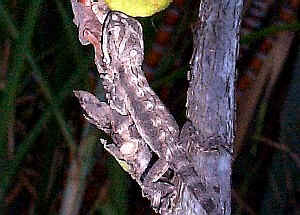
- From head to tail 150mm
- We saw this lizard once hunting insects in our backyard.
- Blue-tongued Skink

- Tiliqua scincoides, from head to tail 400mm
- Sometimes we can see theirs thick blue-violet tongue come out from their mouth. They have thick body and short legs. They are actively searching among plants materials on the ground during the day, hunting for insects. However, they are omnivorous, eat fruit, flowers and eggs as well. When disturbed, they walk away slowly. They can be find in Brisbane house backyards and bushlands.
- Red-bellied Black Snake
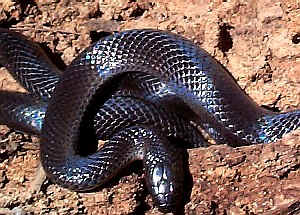
- Pseudechis porphriacus, length about 1m
- We found this snake in winter under a rotting tree truck while it was hibernating. Because of our disturb, it woke up and moved away. Then we saw that its below was pink in colour, and realized that it was the famous Red-bellied Black Snake, one of the deadly snake in Australia. Seek urgent medical attention for any suspected bite.
- Carpet Python
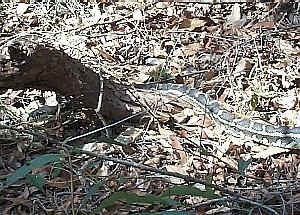
- Morelia spilota, length over 2m
- Pythons are very large and non-venomous snakes. There are the typical python pattern on their body and easy recognized. We sometimes met them when we go for bush-walking. They are mostly found in trees covered area. We take this picture in bush near Mansfield, a suburb in Brisbane.
- Echidna
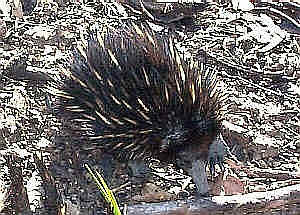
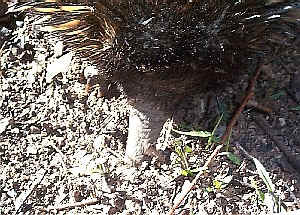
- Tachyglossus aculeatus, body length 300mm
- We saw this Echidna walking across the foot path during our bush walking in Daisy Hill Forest. The Echidna was just walking slowly ignoring our approach. It was looking for ant nests. For every ant nest, it stop and feeding for about one minute. It used it long thin tongue to stick up ants. The ants seemed do not react to it, just coming in and out the nest as normal, and some were being eaten. Then the echidna came to anther ants nest. It seems that the echidna know where those ants nests were very well. Echidnas will eat termites as well. Echidnas are egg laying mammal, also known as Monotreme.
- Common Brushtail Possum
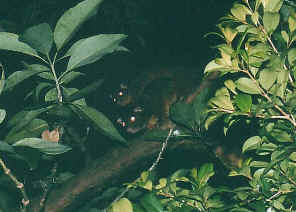
- Trichosurus vulpecula, body length 500mm.
- They are common in Brisbane suburb. At night we can sometimes see them walking between tress and fences. The above picture shows the mother and her child.
- Australian Wood Duck, Maned Duck, Maned Goose

- Chenonetta jubata, length 500mm
- This duck family lives in Mt Coot-tha Botanic Garden. Picture was taken in early summer.
